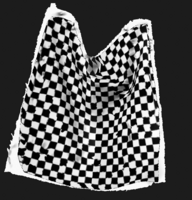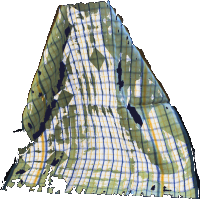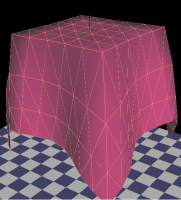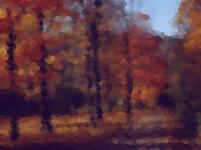I've been interested in computer graphics since high school, in one form or another. I worked for several years at Side Effects Software (Houdini) in Toronto, and I've previously worked as an intern at a few other companies, including Alias | Wavefront (Maya) and Discreet (inferno, 3dsmax). My M.Sc. degree was with Wolfgang Heidrich in the Imager laboratory at the University of British Columbia. I also worked as an undergraduate research assistant with Michael McCool at the Computer Graphics Laboratory of the University of Waterloo.
research.
cloth parameters and motion capture.
During the second year of my M.Sc. degree, I performed a range of research. The research evolved out of my course projects for Wolfgang Heidrich and Michiel van de Panne. Part of my research was presented as a full paper at Eurographics 2003 and published in Computer Graphics Forum, and was also presented as a sketch at SIGGRAPH 2003.
- thesis [html | pdf]
- Eurographics paper
- bibliography of (recent) cloth simulation papers [html | bibtex]

thesis abstract.
Recent years have seen an increased interest in cloth simulation. There has been little analysis, however, of the parameters controlling simulation behaviour. In this thesis, we present two primary contributions. First, we discuss a series of experiments investigating the influence of the parameters of a popular cloth simulation algorithm. Second, we present a system for motion capture of deformable surfaces, most notably moving cloth, including both geometry and parameterisation. This data could subsequently be used for the recovery of cloth simulator parameters. In our motion capture system, we recover geometry using stereo correspondence, and use the Scale Invariant Feature Transform (SIFT) to identify an arbitrary pattern printed on the cloth, even in the presence of fast motion. We describe a novel seed-and-grow approach to adapt the SIFT algorithm to deformable geometry. Finally, we interpolate feature points to parameterise the complete geometry.
course projects.
During the first year of my M.Sc. degree, I worked on a range of graphics-related projects. The scale of most of this work was quite modest, and many of the projects never really amounted to anything. I'm not very proud of these, except for the cloth simulation project.
cloth motion capture.

For Wolfgang Heidrich's graphics course in the winter of 2002, I developed a cloth capture system. Using a Digiclops, I used stereo correspondence to capture an image of the cloth with a depthmap. This was used to make the darker parts of the image to the left. Then, I detected grid points on this cloth to determine how the cloth had been deformed. Using this, I generated a new mesh of the cloth, which is superimposed in brighter colours in the image on the left. My report on that work is available for download [pdf | html].
I've since made a much better cloth capture system, as part of my thesis
research. A paper on this system was submitted to Eurographics 2003.
cloth simulation.

For Michiel van de Panne's animation course in the winter of 2002, I did a project on cloth simulation. I attempted to implement a paper by Baraff & Witkin, and managed to get a lot of it done. I didn't have time to implement the entire paper, so my simulator isn't nearly as fast as it should be. However, I believe that it produces the same results as a full implementation would, and it could easily be fleshed out to a full simulation. I've released this project to the public as a SourceForge project under the LGPL license. The Freecloth homepage is here.
vocal tract visualisation.

In the winter of 2002, I did a project for EECE 593, a course on volume image processing. I started with a series of images obtained using Magnetic Resonance Imaging (MRI). I had to register and then segment these images, in order to determine the shape of the vocal tract. This type of technique has been used in linguistic research to analyse how parts of the vocal tract affect the production of sound, although my goal was simply to practice the volume image processing techniques learned in class. I have publicly released the report [pdf | xhtml+mathml], the manual [pdf | xhtml] and the source code [tar.gz] for that project.
voronoi diagrams.

In the fall of 2001, I did a project for CPSC 516, a course on computational geometry. I compared two approaches to constructing Voronoi diagrams: using a hardware-accelerated technique described by Hoff, and the traditional algorithm by Fortune. Unfortunately, I never got Fortune's algorithm working completely. Even still, I had some results for comparison. The picture here is a mosaic generated using a Voronoi diagram. The report [pdf] is available.
racecar simulation.
One of my other fall courses was CPSC 515, computational robotics. For this course, I collaborated with dave burke to create a racecar simulation. I was responsible for developing the physics model. We were concerned with accurate simulation of physics in realtime. Car manufacturers simulate the physics quite accurately, and video games do some physics is realtime, but there hasn't been a successful game yet that blended the two. Our results were so-so at best, but we read through a lot of relevant literature in the process, as documented in our report [pdf].